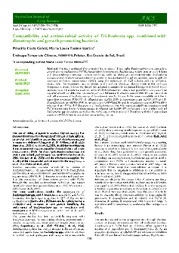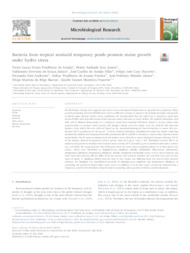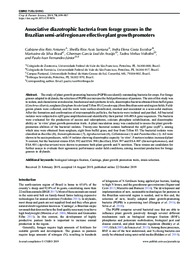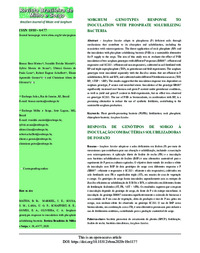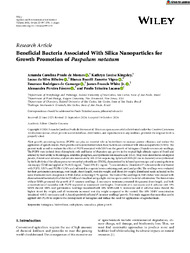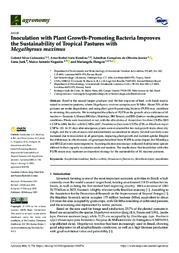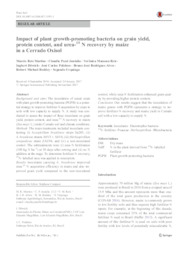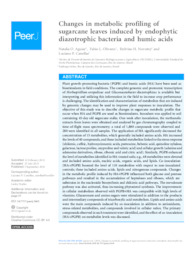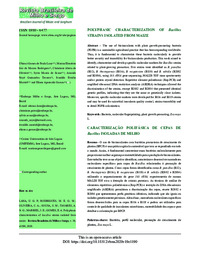Search Publications
Filter by:
| Author(s): GOBBI, P. C.; MATTOS, M. L. T. Abstract: The study evaluated the compatibility, in vitro, of diazotrophs Bradyrhizobium spp., and plant growth-promoting bacteria (PGPB), Azospirillum brasilense and Bacillus spp., widely used as bio... ... |
| Author(s): ARAÚJO, V. L. V. P. de; LIRA JUNIOR, M. A.; SOUZA JÚNIOR, V. S. de; ARAUJO FILHO, J. C. de; FRACETTO, F. J. C.; ANDREOTE, F. D.; PEREIRA, A. P. de A.; MENDES JÚNIOR, J. P.; BARROS, F. M. do R.; FRACETTO, G. G. M. World climate change has triggered soil water stress and imposed limitations on agricultural production. Plant growth-promoting bacteria (PGPBs) have been an efficient strategy to improve the biologic... ... |
| Author(s): ANTUNES, G. dos R.; SANTANA, S. R. A.; ESCOBAR, I. E. C.; BRASIL, M. da S.; ARAUJO, G. G. L. de; VOLTOLINI, T. V.; FERNANDES JUNIOR, P. I. The study of plant growth-promoting bacteria (PGPB) can identify outstanding bacteria for crops. For forage grasses adapted to drylands, the selection of PGPB can increase the field performance of pas... ... |
| |
| Author(s): MATTOS, B. B.; MARRIEL, I. E.; SOUSA, S. M. de; LANA, U. G. de P.; SCHAFFERT, R. E.; GOMES, E. A.; OLIVEIRA-PAIVA, C. A. Sorghum bicolor adapts to phosphorus (P) deficient soils through mechanisms that contribute to its absorption and solubilization, including the association with microorganisms. The direct application... ... |
| Author(s): MORAES, A. C. P. DE; KINGSLEY, K. L.; RIBEIRO, L. DA S.; VIGNA, B. B. Z.; CAMARGO, E. R. DE; WHITE, J. F.; FAVERO, A. P.; LACAVA, P. T. Plant growth–promoting bacteria (PGPB) can play an essential role as biofertilizers to increase pasture efficiency and reduce the application of agrochemicals. Plant growth can be potentialized when t... ... |
| Author(s): GUIMARÃES, G. S.; RONDINA, A. B. L.; OLIVEIRA JUNIOR, A. G. de; JANK, L.; NOGUEIRA, M. A.; HUNGRIA, M. ABSTRACT - Brazil is the second-largest producer and the first exporter of beef, with herds mainly raised in extensive pastures, where Megathyrsus maximus occupies over 30 Mha. About 70% of the pastur... ... |
| Author(s): MARTINS, M. R.; JANTALIA, C. P.; REIS, V. M.; DÖWICH, I.; POLIDORO, J. C.; ALVES, B. J. R.; BODDEY, R. M.; URQUIAGA, S. The inoculation of cereal crops with plant growth-promoting bacteria (PGPB) is a potential strategy to improve fertilizer-N acquisition by crops in soils with low capacity to supply N. A study was con... ... |
| Author(s): AGUIAR, N. O.; OLIVARES, F. L.; NOVOTNY, E. H.; CANELLAS, L. P. Plant growth-promoting bacteria (PGPB) and humic acids (HA) have been used as biostimulants in field conditions. The complete genomic and proteomic transcription of Herbaspirillum seropedicae and Gluc... ... |
| Author(s): LANA, U. G. de P.; RODRIGUES, M. E. G. de M.; OLIVEIRA-PAIVA, C. A.; SOUSA, S. M. de; TAVARES, A. N. G.; MARRIEL, I. E.; GOMES, E. A. The use of bioinoculants with plant growth-promoting bacteria (PGPB) is a sustainable agricultural practice that has been expanding worldwide. Thus, it is fundamental to characterize these bacteria mo... ... |
Observation
Some of Embrapa's publications are published as ePub files. To read them, use or download one of the following free software options to your computer or mobile device. Android: Google Play Books; IOS: iBooks; Windows and Linux: Calibre.
Access other publications
Access the Agricultural Research Database (BDPA) to consult Embrapa's full library collection and records.
Visit Embrapa Bookstore to purchase books and other publications sold by Embrapa.

